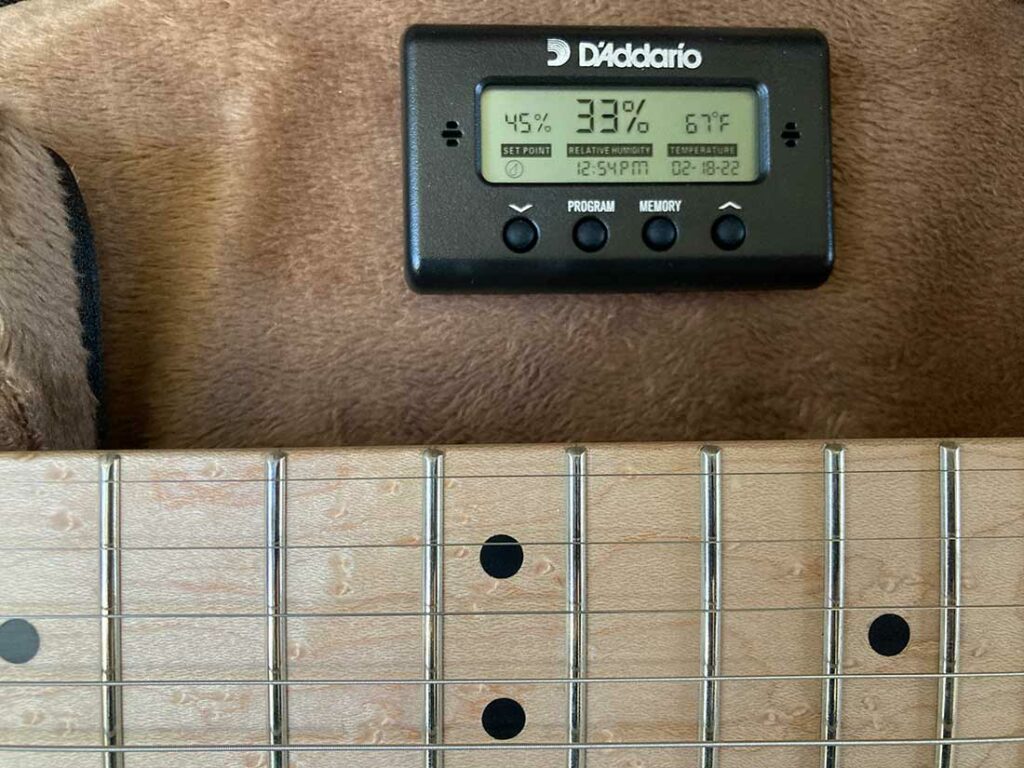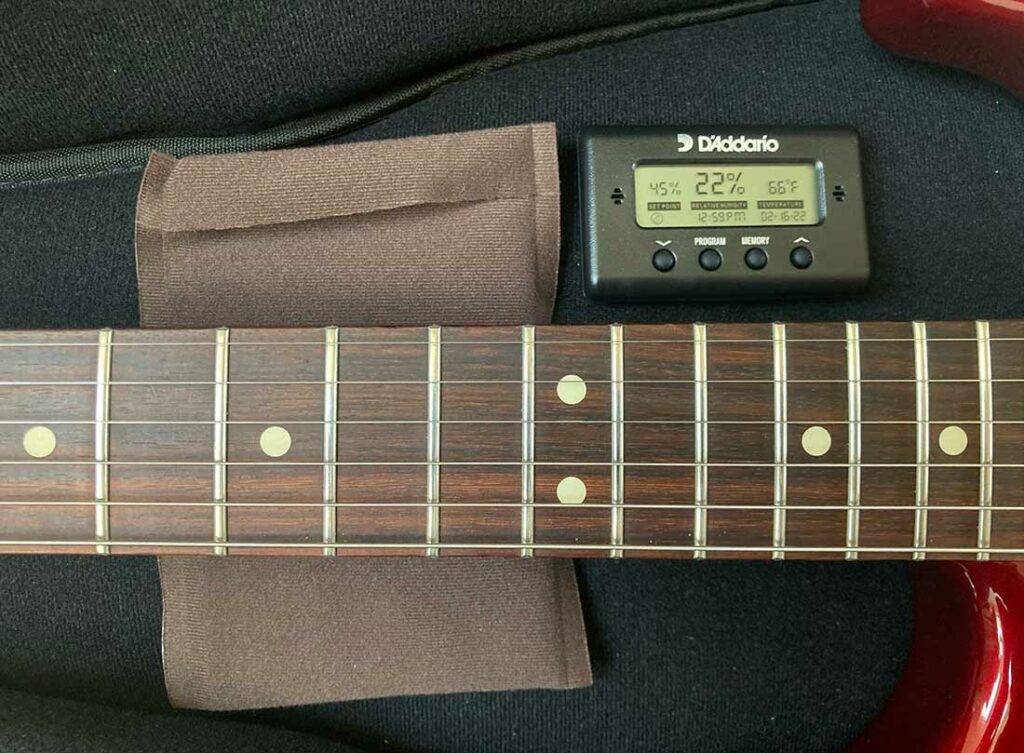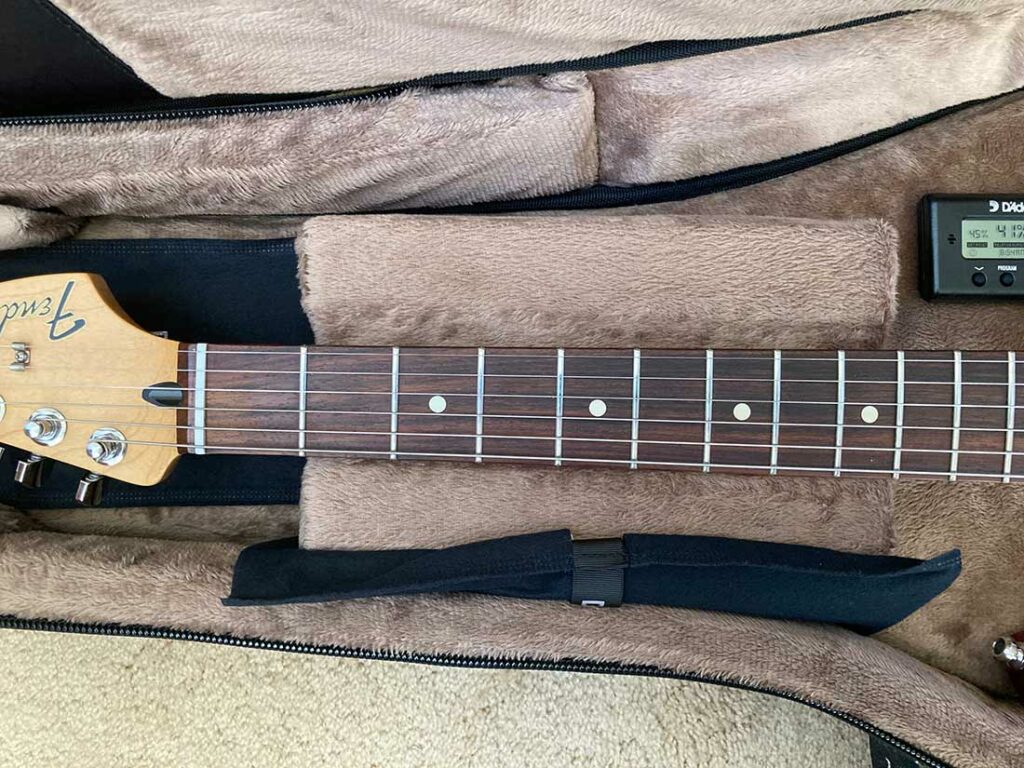Guitar River is reader-supported. We may earn a commission when you make a purchase using the links on our site.
Learn more.
Can You Humidify a Gig Bag? We Find Out

Winter is upon us once again. Depending on where you are in the world, that means your heating system is on, and the air in your home is dry. This can cause problems for your guitar. Ideally, you keep your guitar in a case with a humidifier. But what if a gig bag is your only option? Can you humidify a gig bag?
You can humidify a gig bag, but the results will vary depending on the type and quality of the gig bag. Generally, this is not as effective as using a case humidifier in a hard-shell guitar case. A gig bag is not as airtight as a hard case, and the moisture is not evenly distributed throughout the gig bag.
It’s easy enough to humidify a hard-shell guitar case – add a humidifier packet and shut the case. But a gig bag is more porous. The gig bag zipper is bound to leak air, and the fit is not as snug as a guitar case. Still, adding a humidification packet should do something, right? Let’s find out.
Why Would You Want To Humidify a Gig Bag?
As we covered in our post about whether or not you should humidify your electric guitar, instruments can be adversely affected by dry air. While solid-body electric guitars are more resistant to low humidity, I know from experience that fret sprout can be an annoying issue.
The fretboard can dry out and shrink, causing the frets to stick out from the sides of the neck. This is something that needs to be corrected by a luthier or skilled guitar technician. If you can prevent fret sprout from happening in the first place, you’ll save yourself a repair bill.
If you want to save time, go ahead and invest in a quality hard-shell case, such as the SKB-66 Deluxe Universal Case, or the Gator Deluxe ABS Molded Case. These cost about $150-200. The question is whether we can get by by humidifying a gig bag or not.
So Here’s The Test Plan
I have two gig bags, a Gator Transit, and a Fender FE620. I just placed new humidifier packets from Boveda in each case. I’ll take a measurement with a hygrometer at the start of the process, and at the end after 24-48 hours.
As a control, I’ll also take a measurement with an Ibanez hard-shell case to see what the difference is. I added new Boveda packets at the same time, a few days before this test.
I’m curious to see whether the gig bags retain any moisture or not. The air in my house is currently very dry, at 29% relative humidity. So, that’s not ideal for instruments. I have a room humidifier running, but that does not seem to do much.
Ideally, you would want a whole-house humidifier as part of your HVAC system. That can get expensive and may not be feasible. The next best thing would be to keep your guitar in a hard-shell case with a humidification system. Or, you could try to humidify a small room with a room humidifier.
The least desirable option would be to use a gig bag with a humidification system. However, guitar cases can get expensive, especially if you need to buy more than one. Quality gig bags can also be an investment. You might even prefer to use a gig bag.
So let’s see what happens in a real world scenario, and whether it makes any sense at all to humidify a gig bag.
Test With The Gator Transit Gig Bag
At the beginning of the test, the hygrometer reads 34%. The room thermostat tells me my indoor air is at 36% relative humidity. After 24 hours, the hygrometer reads 33%, and the room humidity is 35%. The gig bag environment was not any better than the air in the room.
I positioned the Boveda humidifier packet near the headstock. It sits neatly at the neck rest for the guitar, with no need to jury-rig anything. I feel comfortable that it would stay in place, and not touch the guitar neck.
The Gator Transit has a bit more room than the Fender, and also a plusher interior. The zipper seems to be heavier. I think this will get us closer to a hard-shell case.

Test With The Fender FE620 Gig Bag
At the beginning of the test, the hygrometer reads 22%. The room thermostat tells me my indoor air is at 29% relative humidity. After 24 hours, the hygrometer reads 35%. The thermostat reads 36% relative humidity. So the gig bag is not any better than the room.
With the Fender FE620, there was no good place to stick the humidifier packet without it touching the guitar. I rigged up a string to hold the humidifier packet in place, and keep it away from the instrument.
The bag is a tighter fit than the Gator with less room for the air to circulate, and I don’t think it will retain the moisture as well.

Ibanez ABS Hard-Shell Case Control
At the beginning of the test, the hygrometer reads 33%. The room thermostat tells me my indoor air is at 35% relative humidity. After 24 hours, the hygrometer reads 32%, and the indoor humidity level is 29%.
After about a week, the humidity level in the case was up to 39% and the indoor humidity level was 33%.
The ABS hard-shell case is the only one where the humidity level increased within 24 hours. And within a week, the humidity level was significantly higher than the relative indoor humidity.
Take Two
Since the Boveda packets didn’t seem to do much in the gig bags, I decided to order the Humidipak Restore kit. In order to humidify a dry case, we need a humidifier with higher moisture content.
The Humidipak Restore kit is designed to be used in a case that has not been humidified. Once it has been humidified, you swap the Humidipak Restore kit for the Humidipak Maintain kit.
I think the Boveda packets will work if your case is already at the property humidity level. But to get it there, you need to use something with more moisture.
Fender FE620 Gig Bag
I gave up on trying to humidify the Fender FE620 gig bag. I don’t think it is practical, and the humidifier packs start to get expensive. Instead, I want to focus on the Gator Transit gig bag.
Gator Transit Gig Bag
I placed all three Humidipaks in the Transit bag. The indoor relative humidity level was 35% at the start of the test.
D’Addario advises that you leave the humidifier in there for two weeks in order to get it fully humidified.
After two days, the gig bag humidity was already up to 39% with 33% indoor humidity. In three days, the bag humidity was up to 40%, with an indoor humidity level of 32%.
About a week later, the humidity level in the Gator Transit bag was 41%.

The Takeaway
So, yes in theory, you can humidify your gig bag. If you have a high-quality gig bag such as the Gator Transit or the Mono Vertigo, you might be just fine. But it’s harder to place a humidifier in your gig bag without it resting on the guitar. And a hard-shell case is going to give you a more consistent environment.
You may need to monitor the humidity in a gig bag more closely as it is more porous, and will have more air exchange with the surrounding environment.
What The Experts Say
I was curious what an expert would think, so I talked to my representative at Sweetwater. He generally advised against humidifying a gig bag for the same reasons we discussed here. Instead, he recommended buying a good hard-shell case, and using a case humidifier.
Our Recommendation
Our recommendation is to buy a nice ABS molded hard-shell case. The ABS exterior will help retain the humidity from a humidification system, as well as providing extra protection for your guitar.
My suspicion is that an ABS case will retain more moisture than a wood case, but we’ll leave that for another test!
I was impressed with how well the Humidipak kit worked. I plan to upgrade a couple of gig bags to ABS cases, and use the Humidipak system moving forward. That approach should prevent future fret sprout issues and avoidable repair bills.
Links and Resources
SKB-66 Deluxe Universal Electric Guitar Case
Gator Deluxe ABS Molded Electric Guitar Case
D’Addario Humidipak Restore Kit



